As Handshake seeks to expand access to relevant opportunities for your students, balancing student trust, school guidance, and employer access is paramount. At Handshake Access 2021, and again in July and September, we hosted a presentation called Reimagining the Employer Trust Score. In it, we discussed our plans to enhance the process for approving employers and jobs for your students by updating our Trust Score and flagging system.
You can watch the full presentation here, or read on for a summary.
Background
Just about every school in the Handshake network will tell you that reviewing employers and jobs takes a lot of time. Schools new to Handshake typically see a 2-3x increase in reputable job postings versus their old system. As a result, they spend an average of 240 hours per year vetting incoming employers and jobs for legitimacy and fit for their students.
At the same time, new employers on Handshake often struggle to get a foothold. The existing Trust Score amalgamates various factors to help schools vet employers; however, those factors become opaque when reduced to a 0-100 score. 55% of employer requests are ultimately declined. This disproportionately disadvantages smaller employers, who don’t always have the time or resources to understand the Trust Score.
The result? On average, students see about 3% of available job postings on Handshake.
We’ve spent the last year discussing these challenges with schools and employers. We worked closely with our Trust & Safety Advisory Board, representing over 20 different institutions, to ensure that the solution would benefit our school partners. As a result, we identified opportunities to make employer and job approvals more nuanced, transparent, and safe.
“We really appreciate the attention that Handshake provides...you all are ridiculously attentive to your clients, and truly take the feedback we share with you seriously.”
Craig Marinello, Manager of Student Employment and Internship Development | Southeastern Louisiana University | Trust & Safety Advisory Board Member
Rather than depending on the Trust Score to stand in for the myriad reasons an employer might not be a fit for your students, our solution separates employer fraud, employer profile validity, and school fit into distinct buckets. This will help schools make more informed decisions around approvals.
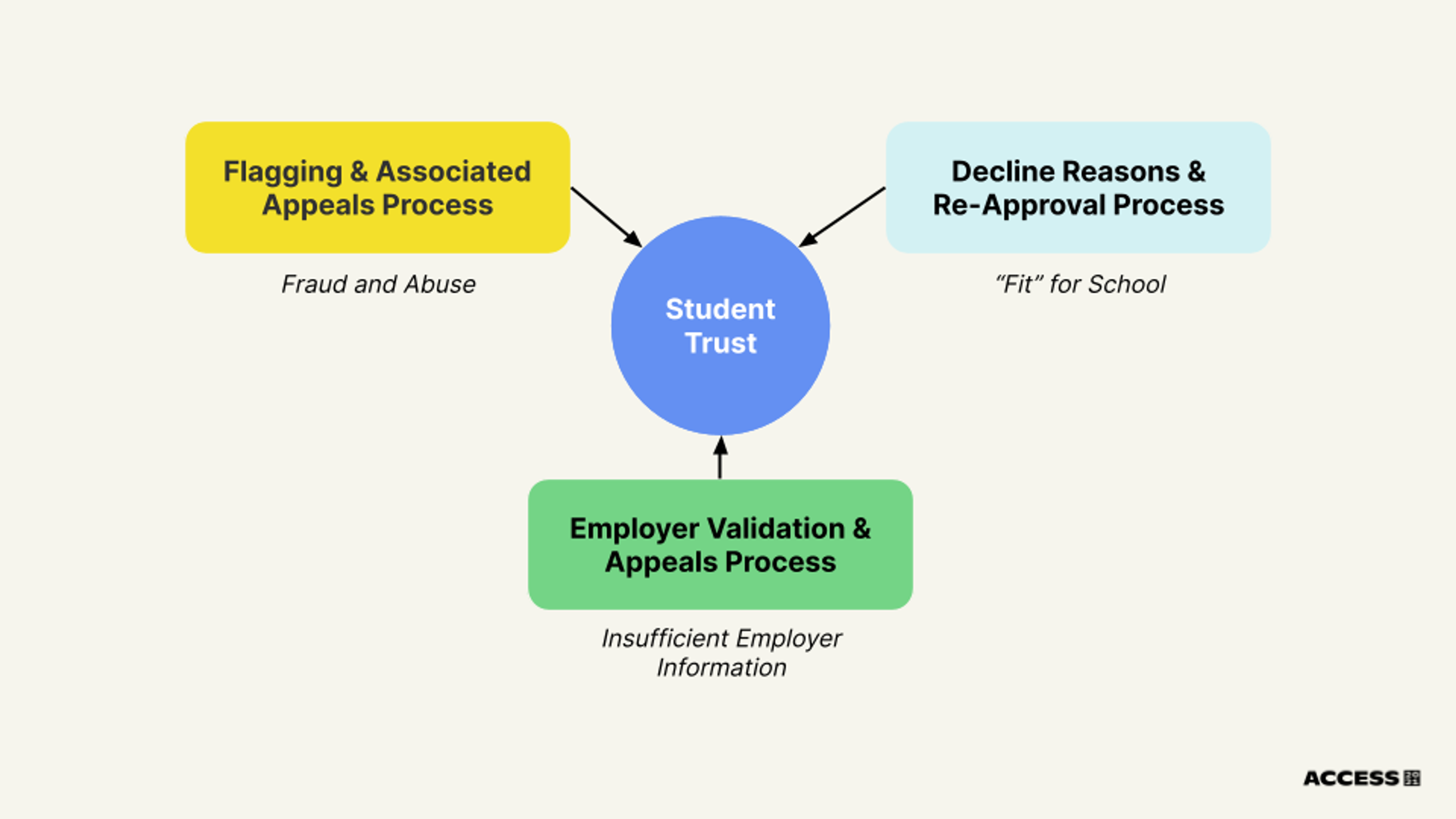
Flags that focus on fraud and abuse
Employer flags were developed as a way to identify bad actors and remove them from the Handshake network. However, over time, we’ve seen a plurality of flags fall into the “other” category. This reduces the efficacy of the flagging mechanism, as it obscures genuine flags.
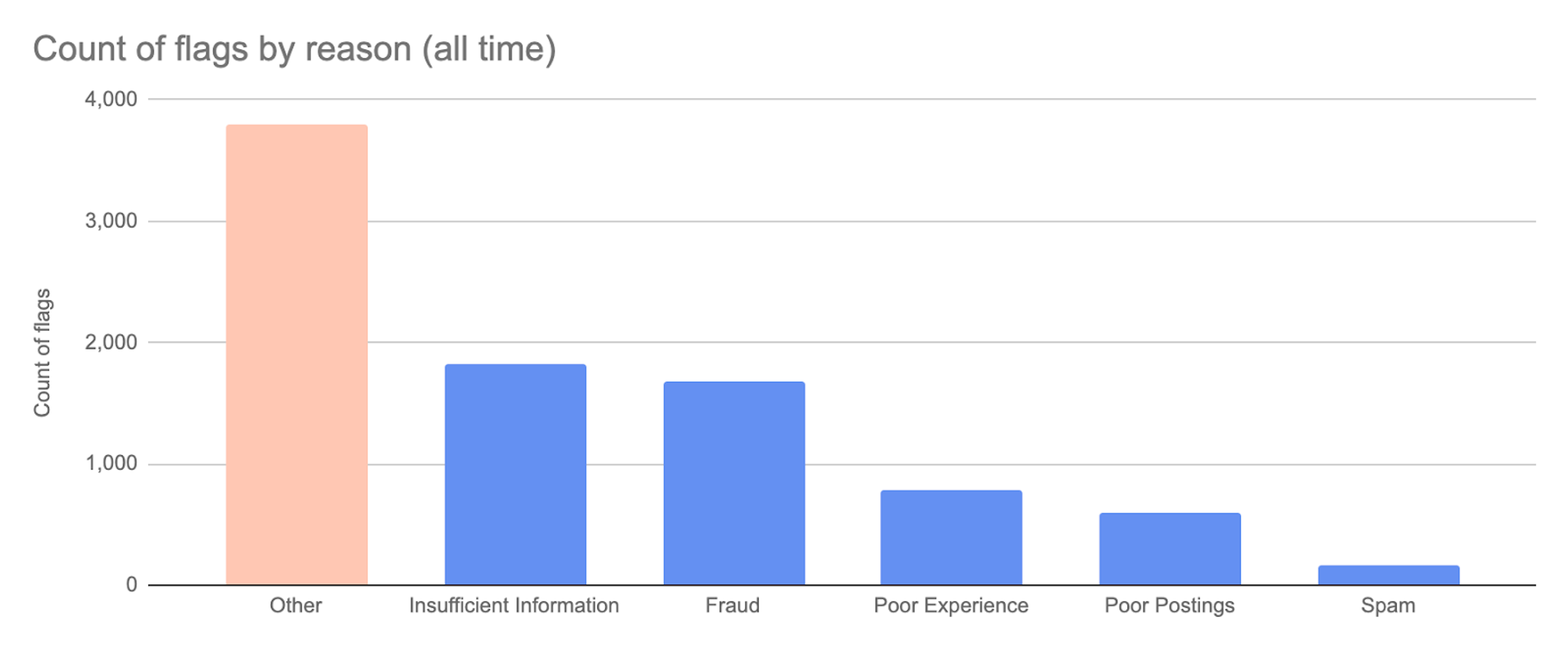
To resolve this challenge, we will:
- Revamp flag taxonomy to focus only on fraud and abuse
- Allow schools and students to flag both employers and employer users
- Notify schools when a previously approved employer receives a legitimate flag for fraud or abuse
Check out our updated flag reasons below:
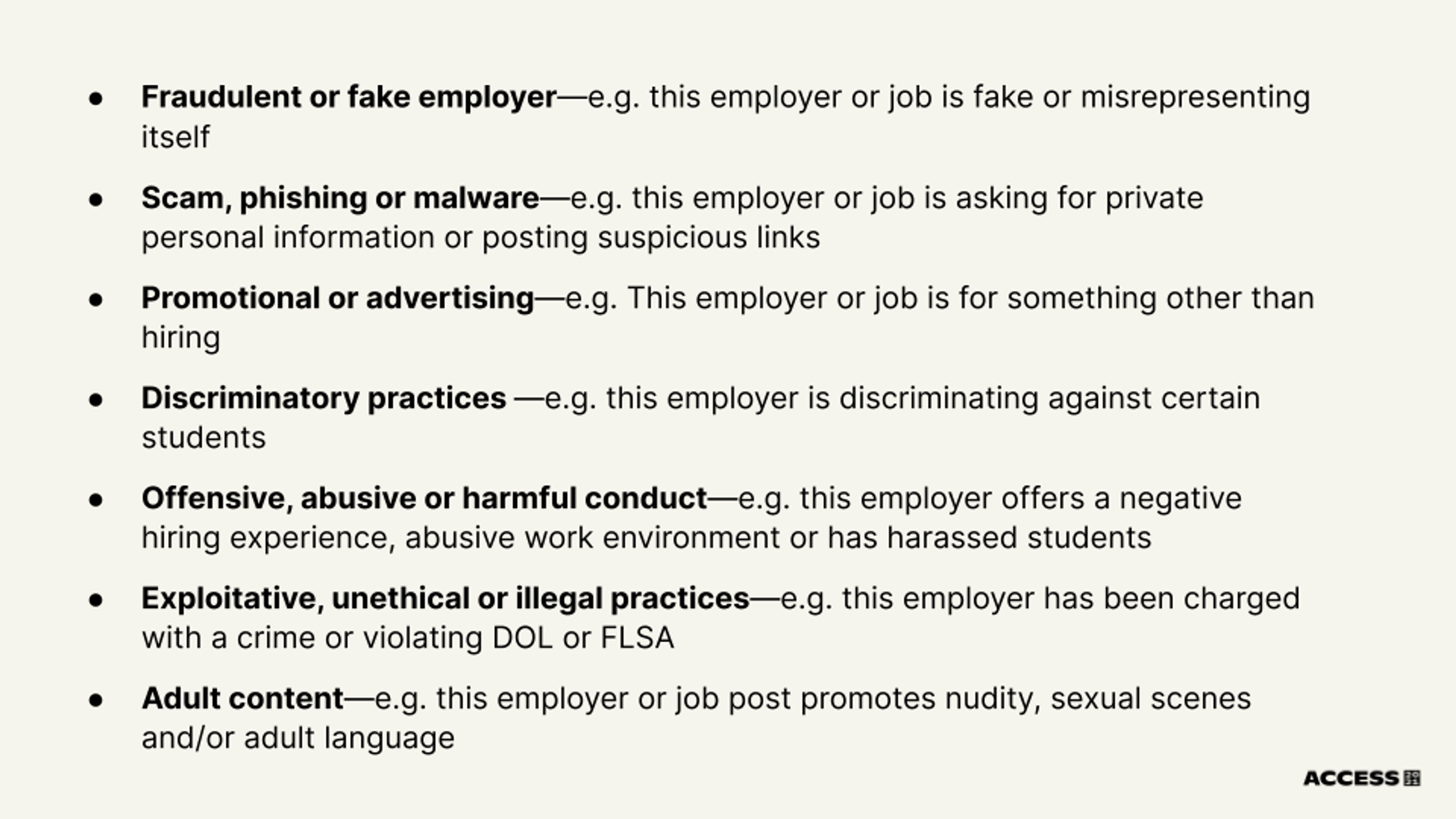
More nuanced reasons to decline employers and jobs
Currently, when you decline an employer on the index page, you’re given the option to provide a reason. Doing so can help employers better understand your decision and provide a signal to Handshake (and your peers) about the fit of the employer for your students.
That said, today, decline reasons aren’t required everywhere in Handshake (only on the index page), and can’t be used to help other schools make approval decisions. They also play double or triple duty, acting both as flags and to call out missing profile information that should be required (more on the latter in the next section). Furthermore, decline reasons don’t exist for jobs—just employers. Including job decline reasons could provide additional signals—for instance, what if the employer is legitimate, but the job isn’t the right fit for your students?
To resolve these challenges, we’re updating employer decline reasons, adding job decline reasons that focus specifically on “fit” for a school, and prompting for decline reasons throughout the product.
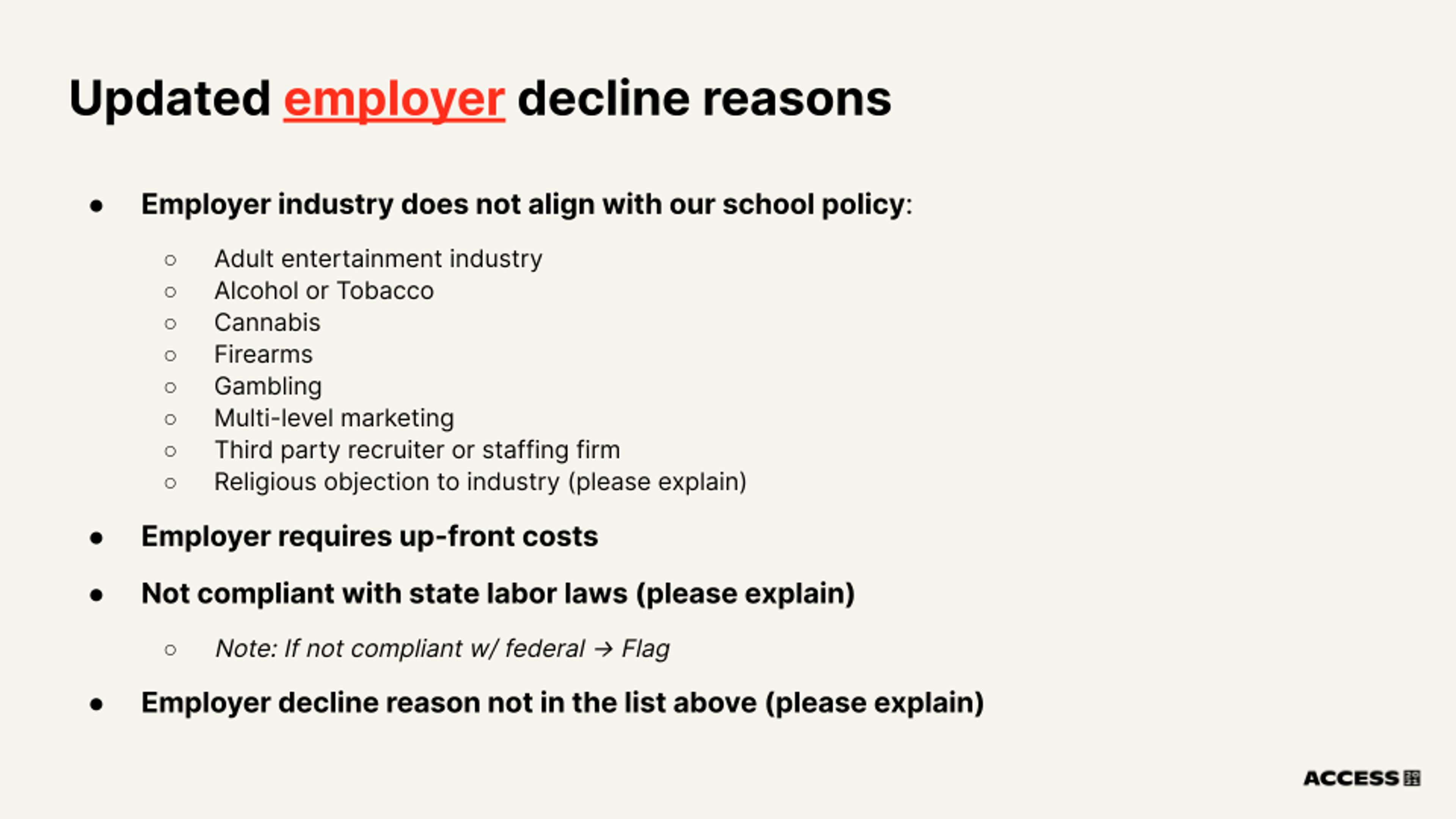

In the future, we’ll be able to map decline reasons to employers on the backend of Handshake. Then, we will be able to provide nuanced filters to help you quickly decline employers or jobs based on information from your peers. For example, if your institution does not approve third party employers, in the future you will be able to easily identify and decline them.
Reimagining the Trust Score
As it stands today, the Trust Score focuses on four main inputs:
- Sufficient employer profile information
- Age of employer on the Handshake network
- Number of school approvals and declines
- Existing flags
Every new employer has a Trust Score of N/A until they get their first job posting approved. There is also no distinction between different reasons an employer is declined. A decline is a decline, as far as the Trust Score is concerned, even if the employer is legitimate and the issue is simply school fit. Finally, the age requirement of the Trust Score unfairly disadvantages new employers.
With flags focused on suspected fraud and decline reasons focused on fit, Handshake’s initial assessment can focus specifically on validating employer profile information.
This new process of employer validation will determine whether the employer’s profile information proves their legitimacy. In its new form, the process of validation can be completely handled by Handshake. This change eliminates the need for the old Trust Score, which we’ll phase out in 2022. Plus, schools will not have to take the time to manually review new employers' profile information. Any employer on the Handshake network will have first been validated.
Employer validation will have two tracks—either way, an employer must be validated before they can do anything on Handshake:
- Automatic Validation: Provide enough profile information to be validated near-instantaneously.
- Manual Validation: Provide available profile information and work with Handshake’s Trust & Safety Team to be validated manually in a day or two.
Employers going through manual validation will be able to share an institutional affiliation—essentially a point of contact from your office—to help our team verify their legitimacy.
This can help you ensure that small, local employers you work with closely are able to get started on Handshake
The Trust & Safety Advisory Board was very enthusiastic about the potential impact of these changes:
"Thanks for the time savings that this represents for our team. We're very grateful.”
Kim Heitzenrater, Director | Sewanee: The University of the South | Trust & Safety Advisory Board Member
"What really excites me about this process is that we could potentially auto approve all employers and spend our time approving jobs that are most relevant to our students.”
Geni Harclerode, Director, Employer Recruitment and Engagement | Northwestern University | Trust & Safety Advisory Board Member
Summary & Timeline
Taken together, updating employer flags, creating new reasons to decline employers and jobs, and the new employer validation process will provide layers of verification that maintain a strong, safe, relevant network.
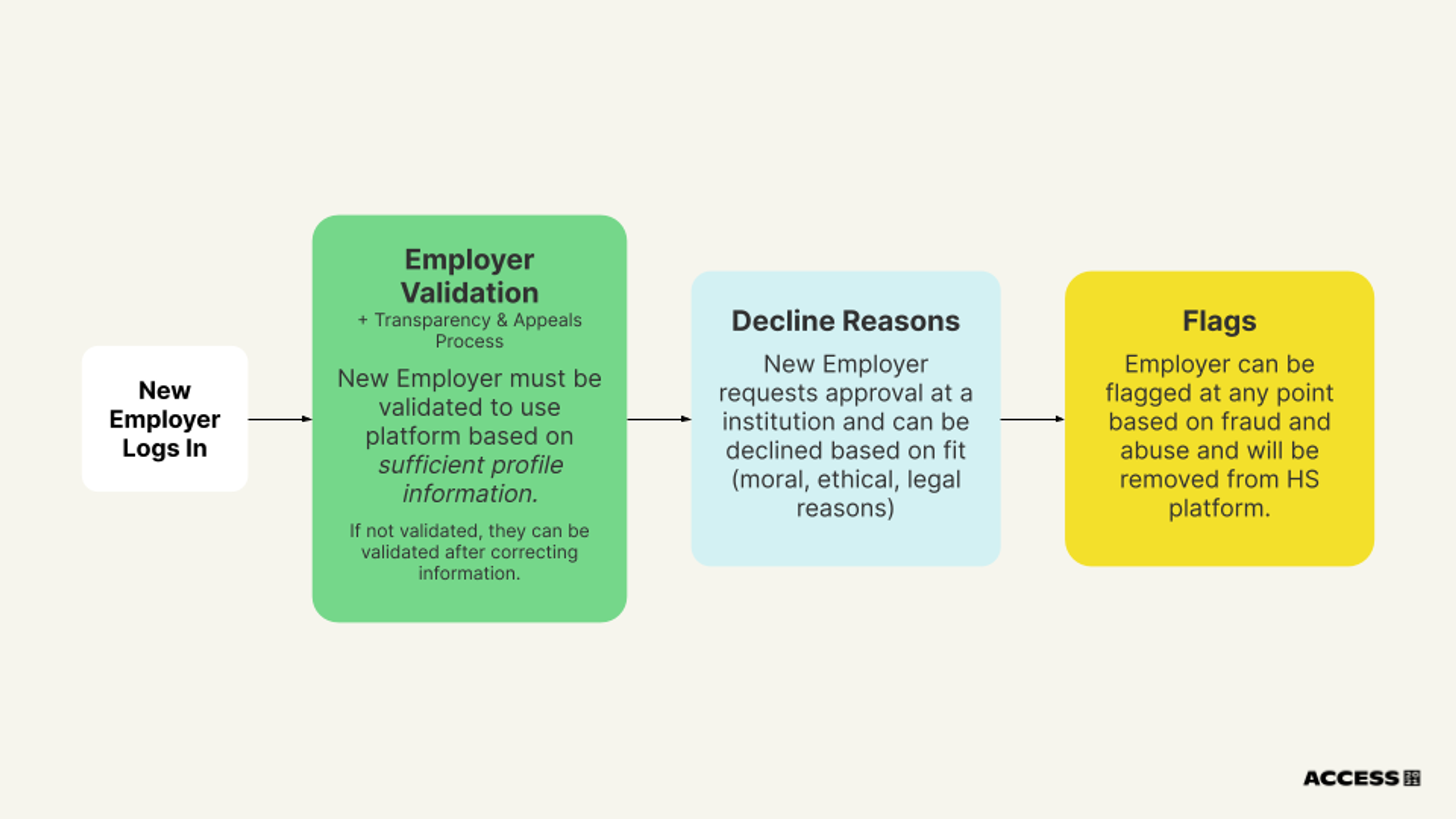
We plan to roll these updates out slowly, in close coordination with our school partners. Check out a rough timeline below:
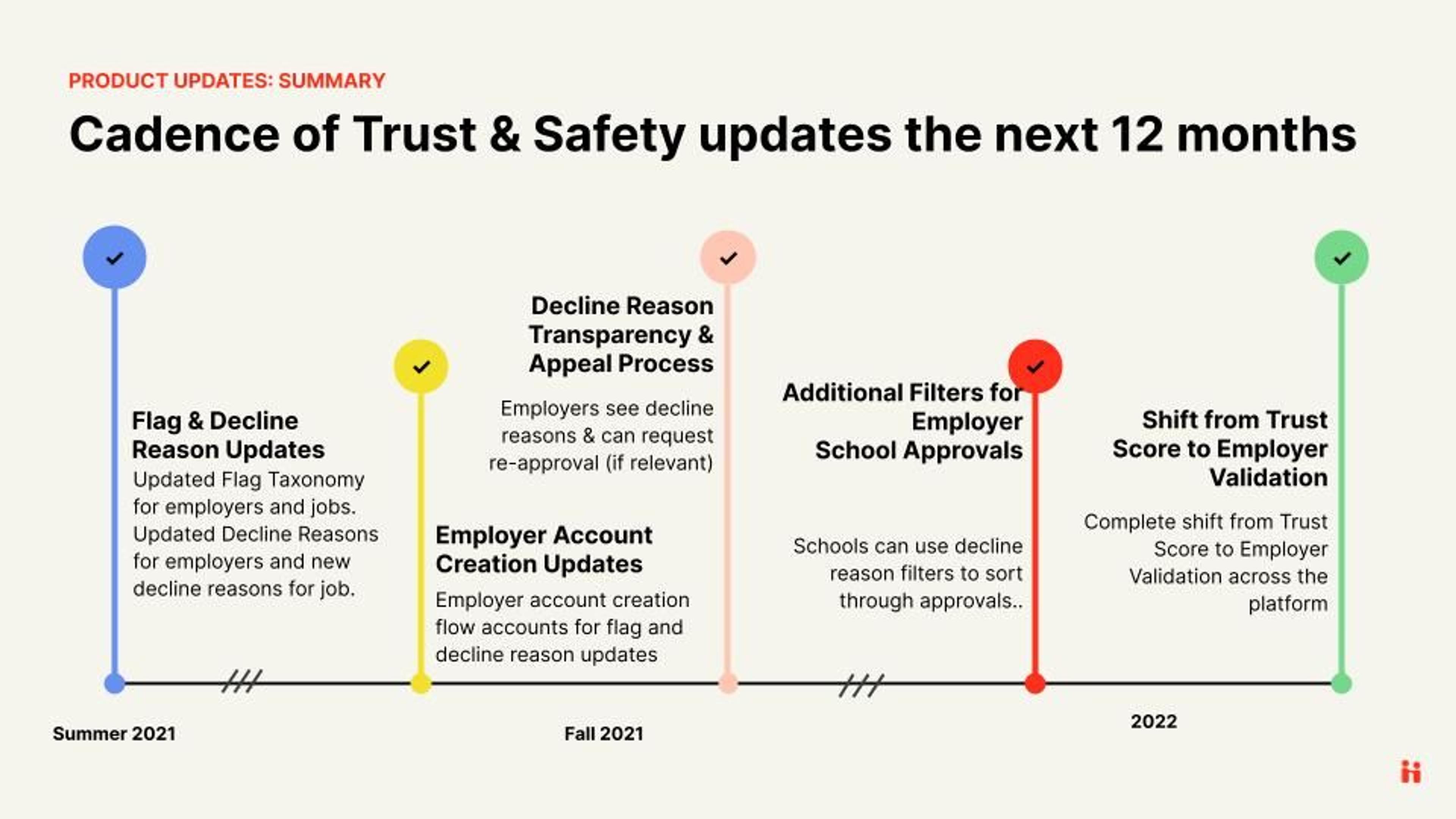
The future of Handshake’s employer and job relevance work
In 2022 and beyond, we will build on these updates to bring even more power to schools to craft a relevant experience for their students on Handshake.
- Flipping Approvals: With more nuanced decline reasons logged, we hope to eventually reduce the amount of time your team spends on employer approvals and allow you to pre-set filters that quickly identify which employers you'd like to review manually.
- Signal Boosting: We’ll allow schools to promote unique opportunities to relevant students within Handshake.
Taken together, these updates will help you set a baseline of fit and safety for your students, saving you administrative time and helping you act as expert consultants for your students. More information to come!
Want to learn more?
Again, rest assured that the initiatives we’ve discussed will roll out slowly and in close coordination with our education partners. We feel confident that these changes will positively impact you and your students. Thus, we want to work with you to make sure you’re fully up to speed as we implement these changes and have the opportunity to guide us with your feedback along the way.
Is there more I can review?
You can watch the recording of our presentation from Handshake Access here. If you’re interested in more context around these initiatives, we highly recommend reviewing these highlights from Christine Cruzvergara’s keynote at Handshake Access.
Then, on July 22, we’re hosting an encore presentation to talk through this initiative again—we highly encourage you to attend. It’ll be another good opportunity to ask questions and share your feedback.
We’re also restarting our weekly office hours sessions in August to provide even more space for conversation—stay tuned for more details on that front. Finally, please do not hesitate to reach out to your relationship manager to discuss these changes. We’re eager to hear from you and answer any questions you might have!
